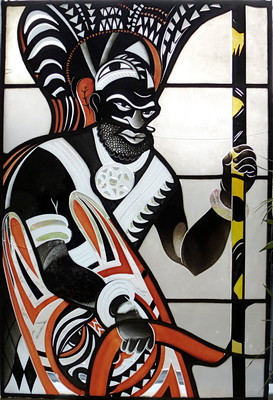Cesar Klein (1876-1954)
As painter, graphic artist, decorator, interior and theater designer, Cesar Klein at the time of the Grassimuseum commission in the 1920s could already look back on a respectable career. Born in Hamburg, he trained at the local School of Applied Arts, went on to study at the Düsseldorf Art Academy and finally under Max Seliger (1865-1920) at the Kunstgewerbemuseum (Royal Museum of Applied Arts) in Berlin. He was a free-lance painter during his entire adult life. In 1910, he was among the 27 artists rejected by the Berlin Secession who promptly founded the “New Secession” lead by Georg Tappert and including the Brücke artists Emil Nolde, Erich Heckel, Ernst Ludwig Kirchner and Max Pechstein as well as other expressionist artists. In late 1910, Cesar Klein founded together with Bruno Paul, Peter Behrens, Max Pechstein, Gottfried Heinersdorff and others the Berliner Künstlerbund für Glasmalerei und Glasmosaik (Berlin Artists’ Association for Stained-glass Painting and Glass Mosaics) whose primary mission was to develop and realize ideas for modern stained-glass painting.
In 1918, he was founding member of the Novembergruppe (November Group) and in 1919 initiated the Arbeitsrat für Kunst (workers’ council for art) in close collaboration with Bruno Taut, Walter Gropius and Alfred Behne. It was in this year that Gropius summoned Klein to teach at the Bauhaus in Weimar. All he had to do was sign the contract for a teaching position at the Bauhaus that already carried Gropius’ signature, but Klein decided against Weimar and for Berlin.
César Klein - WIKIPEDIA
“Dear Rhythm,” wrote Gropius in his letter of April 30, 1919, “You don’t know how much I regret your turning me down. You were the mainstay of my entire project here. And the students who have already heard the news are also very upset.”
His reasons for turning down the post were manifold, but money and the illness of his first wife, Martha, most likely played a decisive role, as did the fact that he was well established in Berlin. Upon recommendation of the then General Director of the Berlin Museums, Wilhelm von Bode, Cesar Klein was invited to teach the “class for decorative painting” at the school attached to Kunstgewerbemuseum Berlin, and he accepted.
Of his numerous commissions in this period there is one that is especially notable, i.e. the stained-glass wall panels for the tearoom in the villa of the renowned Berlin art dealer Wolfgang Gurlitt, located in Berlin-Tiergarten. These two brilliant examples of Cesar Klein’s stained-glass artistry have been preserved and are now in the Berlin Kunstgewerbemuseum (Museum of Applied Arts, ill. 12).
Irmtraud Dalinghaus, author of the most comprehensive works catalogue for Cesar Klein to date, considers “the projects for the Gurlitt building…are among the main works of expressionist interior design from around 1918/20.”
Around the same time that the windows for the Bruno Paul Room in Leipzig were made (1927) Klein designed windows for the Wertheim department store in Berlin. In Paul Wertheim the artist had found an enthusiastic and knowledgeable client.
His life changed abruptly when the Nazi Party came to power in Germany. In early 1933, he and other professors including Oskar Schlemmer, Walter Reger, Karl Hofer and Ludwig Gies were defamed as “Jewish-Bolshevist” teachers and suspended from their teaching posts. The 1937 Munich “Degenerate Art” exhibition also included works by Cesar Klein. After the Nazis suspended him from his teaching post he withdrew to the country, to Pansdorf near Lübeck, where he lived and worked until his death in March of 1954.
Literature
Ruth Irmgard Dalinghaus, Cesar Klein (1876–1954): Angewandte Kunst – Werkmonographie mit Katalog, 3 vols, unpublished doctoral dissertation
Ruth Irmgard Dalinghaus, ‘Cesar Klein: Angewandte Kunst’, Jahrbuch des Museums für Kunst und Gewerbe Hamburg, 17–19, 1998–2000, pp. 177–98
Link
Information on Cesar Klein and his work may also be found on the website of the Cesar Klein Appreciation Society 

